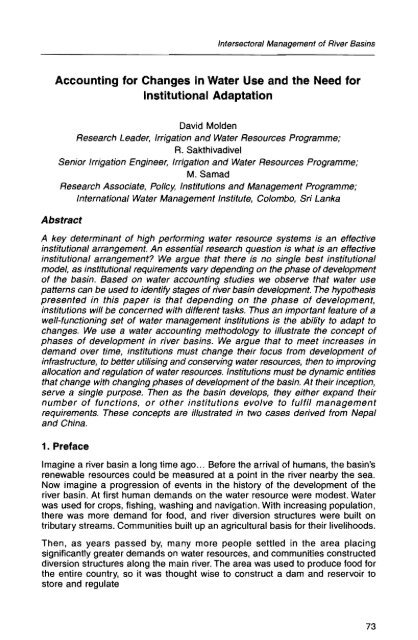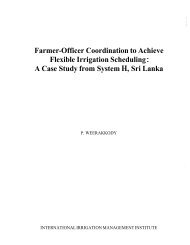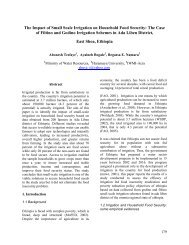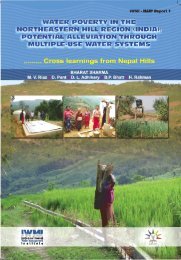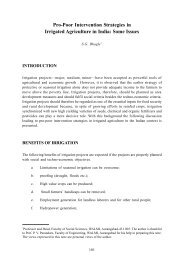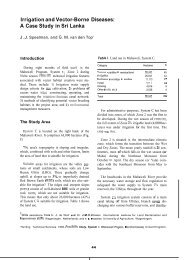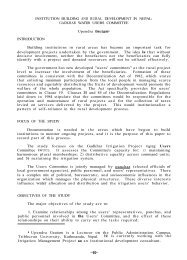David Molden, R Sakthivadivel and M Samad - International Water ...
David Molden, R Sakthivadivel and M Samad - International Water ...
David Molden, R Sakthivadivel and M Samad - International Water ...
You also want an ePaper? Increase the reach of your titles
YUMPU automatically turns print PDFs into web optimized ePapers that Google loves.
Intersectoral Management of River Basins<br />
Accounting for Changes in <strong>Water</strong> Use <strong>and</strong> the Need for <br />
Institutional Adaptation <br />
<strong>David</strong> <strong>Molden</strong><br />
Research Leader, Irrigation <strong>and</strong> <strong>Water</strong> Resources Programme;<br />
R. <strong>Sakthivadivel</strong><br />
Senior Irrigation Engineer, Irrigation <strong>and</strong> <strong>Water</strong> Resources Programme;<br />
M. <strong>Samad</strong><br />
Research Associate, Policy, Institutions <strong>and</strong> Management Programme; <br />
<strong>International</strong> <strong>Water</strong> Management Institute, Colombo, Sri Lanka <br />
Abstract<br />
A key determinant of high performing water resource systems is an effective<br />
institutional arrangement. An essentfal research question is what is an effective<br />
institutional arrangement? We argue that there is no single best institutional<br />
model, as institutional requirements vary depending on the phase of development<br />
of the basin. Based on water accounting studies we observe that water use<br />
patterns can be used to identify stages of river basin development. The hypothesis<br />
presented in this paper is that depending on the phase of development,<br />
institutions wlff be concerned with different tasks. Thus an important feature of a<br />
well-functioning set of water management institutions is the ability to adapt to<br />
changes. We use a water accounting methodology to illustrate the concept of<br />
phases of development in river basins. We argue that to meet increases in<br />
dem<strong>and</strong> over time, institutions must change their focus from development of<br />
infrastructure, to better utilising <strong>and</strong> conserving water resources, then to improving<br />
allocation <strong>and</strong> regulation of water resources. Institutions must be dynamic entities<br />
that change with changing phases of development of the basin. At their inception,<br />
serve a single purpose. Then as the basin develops, they either exp<strong>and</strong> their<br />
number of functions, or other institutions evolve to fulfil management<br />
requirements. These concepts are illustrated in two cases derived from Nepal<br />
<strong>and</strong> China.<br />
1. Preface<br />
Imagine a river basin a long time ago ... Before the arrival of humans, the basin's<br />
renewable resources could be measured at a point in the river nearby the sea.<br />
Now imagine a progression of events in the history of the development of the<br />
river basin. At first human dem<strong>and</strong>s on the water resource were modest. <strong>Water</strong><br />
was used for crops, fishing, washing <strong>and</strong> navigation. With increasing population,<br />
there was more dem<strong>and</strong> for food, <strong>and</strong> river diversion structures were built on<br />
tributary streams. Communities built up an agricultural basis for their livelihoods.<br />
Then, as years passed by, many more people settled in the area placing<br />
significantty greater dem<strong>and</strong>s on water resources, <strong>and</strong> communities constructed<br />
diversion structures along the main river. The area was used to produce food for<br />
the entire country, so it was thought wise to construct a dam <strong>and</strong> reservoir to<br />
store <strong>and</strong> regulate<br />
73
<strong>Molden</strong>, Sakthivadive/ <strong>and</strong> Saroad: Accounting for Changes in <strong>Water</strong> Use<br />
flows. Initially, some farmers benefited, while water scarcity remained a reality<br />
for other less fortunate people in spite of plentiful reservoir supplies. Significant<br />
water re-entered the river as drainage return flows, <strong>and</strong> navigation remained<br />
possible. Yet prosperous farmers needed more water to produce more food for<br />
the nation, so serious efforts were placed in improving management <strong>and</strong> serving<br />
all users. Return flows dwindled, <strong>and</strong> navigation was no longer possible.<br />
To further exp<strong>and</strong> irrigated agriculture <strong>and</strong> to meet urban dem<strong>and</strong>s, individuals<br />
installed pumps to extract water from aquifers <strong>and</strong> drains. Conflicts developed<br />
as upstream uSl;lrs infringed on the traditional rights of downstream users.<br />
Pollution became a concern as urban <strong>and</strong> industrial effluents increased, <strong>and</strong> little<br />
water remained to dilute flows. Wetl<strong>and</strong>s near the coast dried up. Poor people<br />
were left struggling to get sufficient drinking water. Alarmed, communities decided<br />
to take action ...<br />
2. Introduction<br />
Over the last 50 years, changes in the way humans use water have been<br />
enormous. Major driving factors have been a growing popUlation, economic<br />
development, improved living st<strong>and</strong>ards, <strong>and</strong> increasing dem<strong>and</strong>s. Irrigated<br />
agriculture has played a significant role in changing the face of water resource<br />
utilisation as dam, diversion, delivery <strong>and</strong> drainage structures have been<br />
developed to store <strong>and</strong> distribute water for irrigation <strong>and</strong> to drain out surplus<br />
supplies, With more development, we find ourselves in a situation where we have<br />
widely different <strong>and</strong> competing interests in our water resources.<br />
Our working hypothesis is that changing patterns of water use require adaptive<br />
institutions for sustainable, equitable, <strong>and</strong> productive management of basin wide<br />
resource. There is no one set of institutional arrangements that is capable to<br />
adequately manage the present situation, then meet future needs. An important<br />
feature of institutions is the mechanisms they employ to adapt to change.<br />
In order to underst<strong>and</strong> present uses of water, past trends, <strong>and</strong> future projections,<br />
it is essential to underst<strong>and</strong> the physical resource base. Here we present basic<br />
concepts of water accounting as a means of providing this underst<strong>and</strong>ing. We<br />
use water accounting to develop <strong>and</strong> present various phases of water resource<br />
development, <strong>and</strong> problems that are faced during the various phases. We illustrate<br />
these concepts by examples from Nepal <strong>and</strong> China.<br />
3. Accounting for <strong>Water</strong> Use<br />
How much water is available for use within basins or sub-basins? Who are the<br />
major users of the water resource? How much do they use? Is there scope for<br />
water savings, or scope for more development of water resources? These are<br />
the types of questions that can be addressed through the IWMI water accounting<br />
framework (<strong>Molden</strong> <strong>and</strong> <strong>Sakthivadivel</strong>, 1998).<br />
<strong>Water</strong> balance <strong>and</strong> water accounting. <strong>Water</strong> accounting relies on water balance<br />
studies. We define a domain bounded in space <strong>and</strong> by time. For example, we may<br />
74
Intersectoral Management of River Basins<br />
include a portion of a basin over a year's time, bounded spatially so that runoff<br />
is captured by the sub-basin, <strong>and</strong> vertically to include the bottom of the aquifer<br />
up to the top of the vegetation canopy. We perform a water balance to quantify<br />
water flows across the boundaries including rain, evaporation, surface <strong>and</strong><br />
subsurface inflows <strong>and</strong> outflows. Changes in storage internal to the water balance<br />
domain, such as changes in reservoir levels or groundwater levels must be<br />
considered. Essentially, water accounting divides hydrological variables of<br />
discharge, rain <strong>and</strong> evaporation into water accounting categories (Box 1).<br />
Diversions, depletions, <strong>and</strong> recycling: <strong>Water</strong> is diverted to various uses. <strong>Water</strong> is<br />
depleted when it is rendered unavailable for further downstream use-either<br />
through evaporation or by directing the water to sinks. Since not all water diverted<br />
to a use is depleted, some remains within the basin <strong>and</strong> is available for further<br />
use. <strong>Water</strong> recycling or reuse is prevalent in water resource systems. City effluents<br />
discharged back into river systems are often used again downstream. It is<br />
common to underestimate how much reuse exists in river systems, especially in<br />
those that are highly stressed.<br />
Accounting for Precipitation: In many analyses of water resources, only the<br />
"developed" water supply is considered-supply we tap from rivers by diversion<br />
structures. In IWMl's water accounting framework, rain is considered as a supply.<br />
<strong>Water</strong> commitments. All uses of water in a basin could be captured if the<br />
boundaries of a basin were defined to extend to an ideal salt-freshwater interface.<br />
Most often it is practical <strong>and</strong> useful to consider only part of a basin, but when<br />
we do this we have to make sure <strong>and</strong> define commitments of water to downstream<br />
uses to meet ecological or other human requirements downstream.<br />
Open <strong>and</strong> Closed Basins. When all available water has been allocated to various<br />
uses we consider the basin to be closed. When there is water remaining in the<br />
basin to develop <strong>and</strong> allocate, we say the basin is open. In many basins, there<br />
is ample water during part of a year, <strong>and</strong> at other parts it is dry. We consider the<br />
basin to be seasonally closed.<br />
4. Phases of water resources development<br />
Phases of river basin development are defined <strong>and</strong> illustrated (Figure 1) using<br />
the water accounting methodology, building on work presented by Keller et ai,<br />
1998. The rainfall onto a basin or sub-basin plus any trans-basin diversions<br />
represents the gross inflow into the basin. Even if all feasible structures were<br />
built, in many cases it is not possible to tap the entire amount of gross inflow. In<br />
addition, some water may be committed to downstream environmental uses. The<br />
amount of water potentially available for depletive use within the domain is the<br />
gross inflow less non-utilisable flows, less any water commitments.<br />
75
<strong>Molden</strong>, <strong>Sakthivadivel</strong> <strong>and</strong> <strong>Samad</strong>: Accounting for Changes in <strong>Water</strong> Use<br />
Box 1: <strong>Water</strong> Accounting Categories<br />
<strong>Water</strong> Accounting Definitions<br />
•<br />
•<br />
•<br />
"<br />
"<br />
IJ<br />
"<br />
•<br />
Gross Inflow is the total amount of<br />
water flowing into the water<br />
balance domain from precipitation.<br />
surface <strong>and</strong> subsurfece sources.<br />
Net inflow is the gross inflow plus<br />
any changes in storage.<br />
<strong>Water</strong> depletion is a use or<br />
removal of water from a water<br />
basin that renders it unavailable for<br />
further use. <strong>Water</strong> depletion is a<br />
key concept for water accounting.<br />
as interest focused mosfly on the<br />
productivity <strong>and</strong> the derived<br />
benefits per unit of water deplated.<br />
II is extremely important to<br />
distinguish water depletion from<br />
water diverted to a service or use<br />
as not all water diverted to a use is<br />
depleted. <strong>Water</strong> is depleted by four<br />
generic processes:<br />
Evaporation: waler is vaporised from<br />
surfaces or transpired by plants.<br />
Flows to sinks: water flows into a sea.<br />
saline groundwater, or other location<br />
where it is not readily or economically<br />
recovered for reuse.<br />
Pollution: water quality gets degraded to<br />
an extent that it is unlit for certain uses.<br />
Incorporation into a product: through an<br />
industrial. or agricultural process such<br />
as bottling water, or incorporation of<br />
inigation water into plant tissues.<br />
Process consumption is that<br />
amount of water diverted <strong>and</strong><br />
depleted to produce a human<br />
intended product.<br />
·<br />
·<br />
·<br />
·<br />
·<br />
·<br />
Non-process depletion occurs when water is<br />
depleted, but not by the process for which it<br />
was Intended. Non-process depletion can be<br />
either beneficial, or non-beneficial.<br />
Committed water is that part of outflow from<br />
the water balance domain that is committed to<br />
other uses such as downstream<br />
environmental requirements or downstream<br />
water rights.<br />
Uncommitted outflow is water that is not<br />
depleted. nor rommitted <strong>and</strong> is therefore.<br />
available for a use within the domain. but<br />
flows out of the basin due 10 lack of storage or<br />
sufficient operational measures. Uncommitted<br />
outflow can be classified as utllisable or nonutilisable.<br />
Outflow is Ulilisable if by improved<br />
management of axisting facilities it could be<br />
consumptively used. Non-ulilisable<br />
uncommitted outflow exists whan the facilities<br />
are not sufficient to caplure the otherwise<br />
utilisable outflow.<br />
Available water is the net inflow minus both<br />
lhe amount t)f water set aside for committed<br />
uses <strong>and</strong> the non-ulilisable uncommitted<br />
outflow. II represents the amount of water<br />
available for use at the basin. service. or use<br />
levels. Available water includes process <strong>and</strong><br />
non-process depletion. plus Ulilisable<br />
outflows.<br />
A ciosed basin is one where all available<br />
water is deplated. An open basin is one where<br />
there is still some uncommitted UliRsabie<br />
outflow.<br />
In a fully committed basin, there are no<br />
uncommitted outflows. All inflowing water is<br />
committed to various uses.<br />
The actual available water at any time in the course of river basin development<br />
is a function of the existing infrastructure. With all feasible structures built, the<br />
available water is equal to the potentially available water. As time passes, <strong>and</strong><br />
more infrastructure is built, more water is made available. When a new struCture<br />
comes on line, there is an increase in the quantum of available water indicated<br />
by the stair-step pattern in Figure 1.<br />
76
Intersectoral Management of River Basins<br />
Figure 1: Phases of river basin development<br />
Renewable<br />
Potentially available<br />
TIME<br />
Development Utilisation Allocation<br />
As dem<strong>and</strong> increases <strong>and</strong> more water is made available, more water is depleted.<br />
Eventually, the depleted water approaches the available water, <strong>and</strong> a new structure<br />
may be required. In a highly developed basin, depletion approaches the potentially<br />
available supplies. In some cases, water depletion even exceeds the potentially<br />
available resource-in the long-run, a non-sustainable situation. The potentially<br />
available water represents the maximum water that can sustainably be made<br />
available, unless more water is brought in through a trans-basin diversion. This is<br />
equivalent to a "frontier production function" in the field of economics.<br />
Three important stages can be identified (Figure 1):<br />
1. Development. In this phase the amount of naturally occurring water is not<br />
a constraint. .Rather, expansion in dem<strong>and</strong>s drives the need for<br />
construction of new infrastructure. Institutions are heavily concerned with<br />
building infrastructure for providing supplies. Institutions typically emerge<br />
to serve a single function, like construction organisations.<br />
2. Utilisation. Significant construction has taken place, <strong>and</strong> goals are to make<br />
the most out of these facilities. <strong>Water</strong> savings <strong>and</strong> improved management<br />
of water deliveries are important objectives: Managing the supply of water<br />
to various uses is a primary concern. Early in this stage, scarcity is not a<br />
major problem, <strong>and</strong> inter-sectoral competition is minimal. Institutions are<br />
primarily concerned with sectoral issues such as managing irrigation<br />
water, or managing drinking water supplies.<br />
3. Allocation. As closure is approached, <strong>and</strong> depletion approaches the potential<br />
available water, there is limited scope for further development. Efforts are<br />
placed on increasing the productivity or value of every drop of water. An<br />
important means of accomplishing this is to reallocate water from lower to<br />
higher valued uses. Managing dem<strong>and</strong> becomes increasingly critical.<br />
77
<strong>Molden</strong>, Sakthivadive/ <strong>and</strong> <strong>Samad</strong>: Accounting for Changes in <strong>Water</strong> Use<br />
Infrastructure construction is limited to those that aid in regulation <strong>and</strong><br />
control. Little scope remains for "real water savings." Institutions are<br />
primarily involved in allocation, conflict resolution, <strong>and</strong> regulation. Several<br />
important management <strong>and</strong> regulatory functions gain prominence,<br />
including inter-sectoral allocation. To effectively carry out these functions,<br />
either a single entity emerges (like the Brantas River Basin Organisation<br />
in Indonesia), or several inter-linked organisations manage these functions<br />
(as in the South Platte River Basin in Colorado). Co-ordination becomes<br />
important, involving significant transaction costs.<br />
5. Different Phases - Different Needs<br />
Institutional concerns differ depending on the stage of development. These<br />
concerns may exist at all times, but their importance or emphasis may change<br />
over time as illustrated in Table 1.<br />
Table 1: Various concerns at different phases of river basin<br />
development<br />
Development Utilisation Allocation<br />
Construction Improving O&M services Shifting to higher value<br />
uses<br />
Managing supply<br />
Investing in O&M .' Managing dem<strong>and</strong><br />
distribution<br />
Low value of water Increasing value of water High value of water<br />
Large structures Modemisation/rehabilitation Measurement, regulating<br />
Utilising groundwater Conjunctive management Regulating groundwater<br />
Diluting pollution Emerging pollution/salinity Cleaning up pollution<br />
Fewer water conflicts Within-system conflicts Between-system conflicts<br />
Economic water scercity Localised water scarcity Physical water scarcity<br />
<strong>Water</strong> data not so<br />
important<br />
g/excluding poor in<br />
pment of facilities<br />
System water delivery data<br />
important<br />
Including poor in O&M<br />
decision making<br />
Basin water accounting<br />
data important<br />
Cutting off water to poor<br />
In the development phase, infrastructure construction plays a dominant role.<br />
Institutions in the last 50 years have been set up to build major dams, canals,<br />
drinking water treatment <strong>and</strong> wastewater plants. Some agencies are dominated<br />
by civil engineers who have the important job of getting high quality work done<br />
quickly. Examples include the Mahaveli Development AuthOrity or Pakistan's <strong>Water</strong><br />
<strong>and</strong> Power Development Administration. In Nepal's East Rapti Basin, building<br />
infrastructure is a major concern of residents, government agencies, <strong>and</strong> donors.<br />
78
Intersectoral Management of River Basins<br />
Constructing canals <strong>and</strong> managing canal water are two different types of tasks.<br />
Infrastructure projects, especially these serving large areas <strong>and</strong> numerous people<br />
are difficult to manage. The task is to provide water service to people with varying<br />
levels of expectations <strong>and</strong> dem<strong>and</strong>s subject to variations in climate. Even in ideal<br />
situations, this can take a long time to learn how to do. In the early stage, water<br />
utilisation may not be so effective. Reliable <strong>and</strong> equitable service deliveries can<br />
be difficult st<strong>and</strong>ards to reach. As a consequence, water scarcity for individuals<br />
may be a reality because water is poorly managed, or construction quality or<br />
design is poor. Responses vary. Some institutions quickly adapt, <strong>and</strong> improve<br />
water delivery service. In other cases, problems persist. In response, people under<br />
their own initiative, develop alternative decentralised sources like groundwater,<br />
small ponds. or drains.<br />
Eventually through better service, reuse, local initiatives; <strong>and</strong> with growing dem<strong>and</strong>s,<br />
the physical supply of water becomes limiting. <strong>Water</strong> depletion approaches available<br />
supplies. There are two typical responses. If there is more water remaining for<br />
development (available water < potentially available water), exploitation through<br />
more infrastructure development is possible. In the development <strong>and</strong> early utilisation<br />
stages, developing more supplies may be an economically attractive solution<br />
compared to more careful management. Later, as the easier locations are exploited,<br />
or as concerns about environment increase, infrastructure development gets more<br />
costly. Finally, during the allocation phase, the water resource limits. Different kinds<br />
of infrastructure development prevail: measurement <strong>and</strong> regulation structures to<br />
control water become more important; rehabilitation <strong>and</strong> modernisation efforts are<br />
common; there may be scope for transbasin diversions.<br />
Over time, the value of water increases. Early, when water is plentiful, water has<br />
low value, but when the basin is closed, <strong>and</strong> dem<strong>and</strong>s for a scarce resource<br />
intensify the value of water can shoot up dramatically. This leads to a situation where<br />
early in the phases of development we are more concerned with developing supply<br />
of low valued water; while later in the development process, managing dem<strong>and</strong><br />
prevails. When low valued water is plentiful. conflicts can be mitigated with more<br />
supplies. As supplies become limiting, the potential for conflict increases.<br />
Scarcity takes on different characteristics during various phases of development.<br />
Initially, scarcity is felt because there is no way to tap water. "<strong>Water</strong>, water<br />
everywhere but not a drop to drink ... " is a reality for many people who do not<br />
have the technology to access water. In the utilisation phase, the technology may<br />
be present, but when it is poorly managed, people feel water scarcity. This is<br />
common where head-tail problems exist. <strong>Water</strong> accounting examples from Sri<br />
Lanka show that there is sufficient water, but due to poor management, people<br />
still feel scarcity (<strong>Molden</strong> <strong>and</strong> <strong>Sakthivadivel</strong>, 1998). During the allocation phase.<br />
the absolute supply of the physical resource limits.<br />
<strong>Water</strong> scarcity in its various forms during the advancing phases of development<br />
has implications for poverty. During the development phase, an important<br />
consideration is the identification of beneficiaries. Will infrastructure benefit poor<br />
people? Will more powerful people capture benefits? The problems change during<br />
the utilisation phase. Even though conveyance structures exist, management may<br />
79
<strong>Molden</strong>, <strong>Sakthivadivel</strong> <strong>and</strong> <strong>Samad</strong>: Accounting for Changes in <strong>Water</strong> Use<br />
not fit the dem<strong>and</strong>s of the poor. Are the voices of disadvantaged people heard when<br />
making management decisions? During the allocation phase, water is reallocated<br />
amongst sectors <strong>and</strong> people. When water moves away from agriculture to cities <strong>and</strong><br />
industries, will the poor <strong>and</strong> less powerful be able to maintain their right to water; or<br />
capture the economic gains when water moves to higher valued uses?<br />
Environmental concerns also change over time. During development stages, huge<br />
changes in nature can take place. During the utilisation phase, water use <strong>and</strong><br />
depletion intensifies, further removing water that has environmental functions. A<br />
solution to scarCity is to tap into natural heritage sites for more water, resulting<br />
in damaged wetl<strong>and</strong>s. During early phases of development, dilution can be<br />
sufficient to' solve pollution problems. During allocation phases, dilution is not an<br />
option, because there simply is not enough water. Clean-up at the source<br />
becomes increasingly critical.<br />
In the allocation phase, a host of potential problems exist: pollution, conflict<br />
management, resource overdraft. Managing more <strong>and</strong> different types of<br />
information becomes increasingly important. Information needs at the<br />
development phase are different. For design, information on river flows to assess<br />
supply, <strong>and</strong> climate <strong>and</strong> population to assess dem<strong>and</strong>s are necessary. During<br />
the utilisation phase, more information is needed on the delivery of water services.<br />
6. Adaptive Institutions<br />
If early in the development phase, we try to design an institutional framework<br />
that deals with all these issues-pollution, poverty, allocation, regulation,<br />
construction-it is likely that we would fail. At certain phases of development,<br />
some of these are not major concerns. It is probably right that there are<br />
construction agencies to make sure that there is safe <strong>and</strong> sound construction. It<br />
is probably not right that the same institutional set-up is used to manage service<br />
delivery. A different set of rules is required, different skills are required. And those<br />
who manage service delivery are probably not appropriate to regulate allocation<br />
<strong>and</strong> pollution of resources when these problems emerge.<br />
The implication is that water resource management institutions must adapt to<br />
meet different challenges as patterns of water use change. Common water<br />
problems are seen because agencies, at one time competent to carry out tasks,<br />
do not change. When evaluating an institution, we may find that they do 7 out of<br />
10 tasks fairly well. The seven may not be so important, while the three missing<br />
ones, may be critical. When analysing institutions then, we need to underst<strong>and</strong><br />
the mechanisms that exist to adapt to change. Are there rules to change rules?<br />
7. Examples<br />
Let us explore two examples-one taken from Nepal, <strong>and</strong> one from China to<br />
illustrate these concepts. The water accounting finger diagrams are given in Figure<br />
2, The Nepalese example illustrates a case of a basin in the development phase,<br />
while the Chinese basin is closed, <strong>and</strong> is clearly in an allocation phase. Basic<br />
information on the two basins is presented in Table 2.<br />
80
Intersectoral Management of River Basins<br />
Figure 2: <strong>Water</strong> accounting finger diagrams<br />
Gros. 1Inflow<br />
1 l~=· ", Net Innow 1<br />
15993) (61]20) Available<br />
L<br />
wale< (Potential)<br />
15110)<br />
~~~o;<br />
Uncommltied<br />
(3102)<br />
East Rapti (Nepal)<br />
Total<br />
Gross I~flow<br />
(12300)<br />
Net Inr,ow<br />
r3353)<br />
Available now (Potential)<br />
(12217)<br />
Committed for<br />
e1lVlfonment<br />
(10% of available no )<br />
:/<br />
Fuyang River Basin (China)<br />
All units 1Q6m3<br />
81
<strong>Molden</strong>, <strong>Sakthivadivel</strong> <strong>and</strong> <strong>Samad</strong>: Accounting for Changes in <strong>Water</strong> Use<br />
Table 2: Basin characteristics<br />
Particulars<br />
Fuyang River Basin<br />
East Rapti<br />
China<br />
Nepal <br />
Type of basin Sub-basin of Huihe<br />
Of Narayani<br />
Southern Basin<br />
Basin<br />
i Basin area<br />
22814 SQ. km.<br />
312.0 sQ. km. <br />
L<strong>and</strong> use cover <br />
More than 60% forest<br />
I Mean annual<br />
! precipitation<br />
Average annual potential<br />
evapotranspiration<br />
i Population density<br />
Percent involved in <br />
agriculture <br />
Farm size per household <br />
569.2mm<br />
800mm.<br />
685/sq. km.<br />
-<br />
-<br />
1866 mm<br />
1460 mm<br />
212/sq. Km. <br />
80 per::ent <br />
0.9ha<br />
Major crops grown Wheat <strong>and</strong> corn, cotton, Wheat, (Ice <strong>and</strong> maize<br />
oil bearing crops<br />
Average yieldslha 4.26 tlha - wheat 1.85 to 2.5 tlha<br />
4.90 tlha - corn <br />
Major issues 1. Physical water 1. Concern about<br />
scarcity<br />
impacts of increased<br />
2. Inter-sectoral diversion on natural<br />
competition for water habitat.<br />
3. <strong>Water</strong> pollution 2. Population<br />
problem due to rural resettlement <strong>and</strong> its'<br />
industrialisation<br />
impact on present<br />
4. Over-exploitation of water use patterns.<br />
groundwater 3. Soil degradation in<br />
catchment <strong>and</strong><br />
sedimentation<br />
4. Seasonal scarcity<br />
7.1 East Rapti, Nepal<br />
East Rapti River BaSin (ERB) is a part of the Chitwan valley within the inner tarai of<br />
Nepal. draining an area of 3,120 sq, km. The East Rapti river originates from the<br />
Mahabarat range of mountains (MSL 1,500 m), traverses 122 km <strong>and</strong> meets the<br />
Narayani River, one of the four major rivers in Nepal, at MSL 140 m. The Narayani,<br />
called the G<strong>and</strong>ak in India, eventually discharges into the Ganges River. Forests<br />
cover 60% of the area. The average annual rainfall is 1,937 mm, while the average<br />
annual potential evapotranspiration for the basin is 1,460 mm. Rainfall is concentrated<br />
during six months of monsoon period from middle of May to end of October. July<br />
<strong>and</strong> August are the rainiest months receiving nearly half the annual rainfall. Rainfall<br />
during the dry period of six months is only 7 percent of annual rainfall. The river<br />
hydrograph at the confluence of the Narayani River is presented in Figure 3.<br />
82
Intersectoral Management of River Basins<br />
Figure 3: The long-term average monthly discharges at the<br />
confluence point<br />
250 y---------------.----.--.---------------------------- --- ---------------,<br />
_ 200 t-------------------------...---~-__"\-------...,<br />
'1150<br />
~<br />
.. 100 +---------<br />
~O 50<br />
Jan Feb Mar Apr May Jun Jul Aug Sept Oct Nov Dec<br />
The area has a growing population, urban <strong>and</strong> industrial base. Most people<br />
remain engaged in agriculture. The Nepal <strong>Water</strong> Supply Corporation is engaged<br />
in constructing water supply <strong>and</strong> sanitation facilities to serve the needs of growing<br />
cities <strong>and</strong> villages. Irrigation projects are aimed at rehabilitating farmer managed<br />
irrigation systems, or recently in rehabilitating then turning-over agency run<br />
systems to farmers.<br />
There is no major dam or storage facility along the East Rapti. Farmers have<br />
constructed several small diversion structures along the main river <strong>and</strong> its<br />
tributaries. Government agencies have built a few diversion structures, <strong>and</strong> have<br />
recently been involved in the modernisation of farmer constructed works.<br />
There is one major transbasin diversion project where water from the Kulekhani<br />
reservoirs flows through a hydroelectric station into the East Rapti. The purpose of<br />
this project is power generation rather than storage augmentation for the East Rapti.<br />
7.2 Fuyang, Hebel, China<br />
Fuyang River Basin (FRB), a sub-basin of Haihe Southern Basin in Hebei<br />
province of North Chl,na, drains an area of 22,814 sq. km. The basin is divided<br />
into three broad regions: Fuyang river mountainous area', Fuxi plain <strong>and</strong> the Hufu<br />
inter-zone plain. The annual mean precipitation for the basin is 569 mm,<br />
In contrast to the East Rapti, the Fuyang River Basin is heavily equipped with a <br />
large number of storage structures. In FRB, there are 3 large reservoirs, 11 <br />
medium reservoirs <strong>and</strong> 212 small reservoirs. These protect from floods, supply <br />
. water for irrigation, industry, domestic <strong>and</strong> power production. Three-quarters of <br />
water is allocated to agricultural use, 15 percent for industry, <strong>and</strong> 10 percent for <br />
domestic use.<br />
Differences in water accounting indicators are striking (Table 3). At Fuyang, 109<br />
percent of available water is depleted showing that there is now over exploitation.<br />
At East Rapti,this indicator is only 39 percent, meaning that the amount of water<br />
in the basin is not constraining future water resource development. This is further<br />
83
<strong>Molden</strong>, <strong>Sakthivadivel</strong> <strong>and</strong> <strong>Samad</strong>: Accounting for Changes in <strong>Water</strong> Use<br />
illustrated by considering the ratio of uncommitted outflow to available waternearly<br />
0 at Fuyang, <strong>and</strong> 61 percent at ~ast Rapti. At Fuyang, process depletion<br />
(by industries, cities, <strong>and</strong> agriculture) is 83 percent of the available water, while<br />
at East Rapti this is only 5 percent. At Fuyang, water resources are heavily<br />
developed <strong>and</strong> effectively placed in process use, while the process fraction for<br />
East Rapti indicates that humans have harnessed very little of the water.<br />
Productivity of water in agriculture has reached high levels in Fuyang, while at<br />
East Rapti it remains quite low. One possible explanation is that'with increasing<br />
competition for water, the value of water increases, which exerts pressure to<br />
increase productivity of water in agriculture.<br />
According to historical records, during 1950s <strong>and</strong> 1960s, Fuyang River was an<br />
important shipping channel for Hebei province. In contrast, from 1990s onwards,<br />
the river had over 300 dry days annually. The outflows from the basin dramatically<br />
decreased from the late 1970s to less than 100 mm 3 with no outflow in 1997<br />
(Figure 4). The basin has become a closed basin for all practical purposes.<br />
Table 3: <strong>Water</strong> accounting indicators<br />
Unit<br />
Fuyang<br />
River Basin<br />
China<br />
East Rapti<br />
Nepal<br />
Depletion/available water - DF % 109 39<br />
Process/consumption/ Avail water - PF % 83 5<br />
Non-process beneficial use - SF % 12 31<br />
Non-process non-beneficial use - NSF , % 14 4<br />
Uncommitted outflow/avail water 0/0 0.5 61<br />
Committed outflow/avail water % 01.0* 9<br />
Productivity of water depleted by agriculture US$/m' 0.29 0.09<br />
'not supplied.<br />
Figure 4: Variations of discharge measured at Aixinzhuang Hydrology<br />
Station from 1957 to 1998<br />
25<br />
,,<br />
~- - 15<br />
fi5 10<br />
5<br />
o<br />
1955 1960 1965 1970 1975 1980 1985 1990 1995 2000<br />
Year<br />
84
Intersectoral Management of River Basins<br />
In Fuyang, groundwater accounts for 80 percent of supply, while at East Rapti.<br />
groundwater remains a relatively minor source although considerable groundwater<br />
potential exists. As a conscious allocation decision, water managers of Fuyang<br />
have allowed cities <strong>and</strong> industries first priority on reservoir water, <strong>and</strong> have<br />
supported farmers in their efforts to tap groundwater. Groundwater overdraft led<br />
to a dramatic drop of groundwater level. especially in the recent two decades<br />
(Figure 5). The groundwater table dropped at a rate of 0.68 m/year for the county<br />
located at the upstream <strong>and</strong> at a rate exceeding 1 m/year for the middle <strong>and</strong><br />
downstream counties. There is apparently no institutional mechanism for dealing<br />
with this groundwater overdraft problem.<br />
Figure 5: Variations of groundwater depth from the surface, 1980 to<br />
1998, Jiuzhou Station, Renxian County, Hebei Province<br />
I<br />
'"<br />
{!! "<br />
::><br />
'"<br />
£; '"<br />
Year<br />
1980 1985 1990 1995 2000<br />
0<br />
10<br />
E 20<br />
,g<br />
R<br />
30<br />
"0<br />
'"<br />
2<br />
co<br />
;;: 40<br />
"0<br />
c:<br />
::><br />
50 <br />
e<br />
c.'J <br />
For Nepal. groundwater has been recognised as an important resource. But in<br />
spite of an ample groundwater resource, <strong>and</strong> funding for development efforts.<br />
groundwater development has remained limited. Institutional mechanisms to<br />
support groundwater development have not yet been effective.<br />
Environmental considerations differ in the two areas. In the East Rapli Basin,<br />
non-process depletion by natural vegetation accounts for depletion of 35 percent<br />
of the water, a large portion in comparison to Fuyang (26%). An important feature<br />
of the East Rapti basin is the Chitwan National Park, an important nature reserve<br />
<strong>and</strong> popular tourist destination, situated near the tail end of the basin. Maintaining<br />
flows in the East Rapli is essential in maintaining the river ecosystem of the park.<br />
Efforts to build more diversion structures along the East Rapti have been<br />
hampered in part because of concerns about the river habitat of the Chitwan<br />
National Park. There have been no estimates of the flows required for<br />
environmental maintenance.<br />
In the Fuyang Basin, people are alarmed at the levels of pollution in the water system.<br />
Dilution no .longer works, as flows are too small to carry out excess pollutants.<br />
Industries continue to discharge polluted effluents. Salinity levels are also rising from<br />
agricultural practices. Institutions are at least showing some concern, but it is clear<br />
that they do not have the necessary clout to adequately deal with the problem.<br />
85
<strong>Molden</strong>, <strong>Sakthivadivel</strong> <strong>and</strong> <strong>Samad</strong>: Accounting for Changes in <strong>Water</strong> Use<br />
In Fuyang, productivity levels are quite high giving evidence that water <br />
management in agriculture is effective at least promoting productive agriculture. <br />
In East Rapti, cropping intensity is quite high, but crop yields remain low. Farmer <br />
constructed <strong>and</strong> managed systems in this area have often been cited as model <br />
examples for irrigation management, while agency constructed systems struggle. <br />
Management transfer efforts are aimed at improving the quality of delivery <br />
. services. Rehabilitation <strong>and</strong> modernisation of farmer managed systems is an <br />
important concern in the area to promote higher productivity.<br />
In spite of ample water in East Rapti, many farmers do not have water during<br />
the dry months for crop-water scarcity is a reality for them. Within the Fuyang<br />
Basin, the amount of water limits the amount of productivity in the basin. They<br />
have met a stage of absolute, physical water scarcity.<br />
Within the Fuyang River, institutions for providing water delivery services seem<br />
well-developed. Institutions for regulation of pollution <strong>and</strong> groundwater seem<br />
inadequate. At East Rapti, institutions for construction are active. It was<br />
recognised that this setup is not the best for managing water delivery services.<br />
Government agencies are still struggling to find the right formula for improved<br />
water management within government built irrigation systems. Mechanisms for<br />
allocation <strong>and</strong> regulation seem of little concern now, except for the major issue<br />
of allocation between water for food <strong>and</strong> water for nature. It is questionable<br />
whether existing institutions are equipped to h<strong>and</strong>le this problem.<br />
8. Summary <strong>and</strong> Conclusions<br />
The growing recognition of a river basin as the most appropriate unit for the<br />
development <strong>and</strong> management of water resources has prompted the search for<br />
appropriate institutional arrangements for river basin management. This paper<br />
has argued that there is no single "best" institutional model. Rather, institutional<br />
requirements differ with the different phases of development of the river basin.<br />
Thus, a clear specification of the stage of development of the river basin is crucial<br />
in underst<strong>and</strong>ing or formulating institutional arrangements for river basin<br />
management. This paper outlines a framework to define the phases of<br />
development of a river basin on the basis of water accounting. The ideas<br />
presented in the paper are preliminary <strong>and</strong> research is underway to develop the<br />
methodology <strong>and</strong> test it empirically under various conditions.<br />
We demonstrated that as the river basin progresses from an "open" to a "closed"<br />
basin, three phases can be identified: development, utilisation <strong>and</strong> allocation. These<br />
are not mutually exclusive <strong>and</strong> some overlap of functions may occur. At the early<br />
stages of development, institutional arrangements focus on a single or very limited<br />
set of objectives. Very often they are involved in developing infrastructure to supply<br />
water. Later, more concern is placed on managing water within various sectors.<br />
With increasing scarcity brought on by more development, competition increases,<br />
the value of water increases, <strong>and</strong> a host of other issues including environmental<br />
concerns, pollution, <strong>and</strong> groundwater overdraft may arise. Over time they need to<br />
deal with multiple functions that require complex institutional arrangements that<br />
involve several organisations, <strong>and</strong> function in the realm of a broader <strong>and</strong> often<br />
86
Intersectoral Management of River Basins<br />
conflicting set of national objectives. Thus, institutions are dynamic entities that<br />
need to cater to different management dem<strong>and</strong>s as water use changes with the<br />
progression of time. Finally, a key feature of an effective institutional design is<br />
the ability to adapt to changing needs.<br />
Bibliography<br />
CCAP <strong>and</strong> CAAS. 2000. <strong>Water</strong> Accounting for Fuyang River Basin. 2000. Draft<br />
Interim Report prepared by the Chinese Center for Agricultural Policy <strong>and</strong> the<br />
Chinese Academy of Agricultural Sciences for the Five Country Regional Study<br />
on Development of Effective <strong>Water</strong> Management Institutions.<br />
Keller, J.; A. Keller; <strong>and</strong> G. <strong>David</strong>s. 1998. River basin development phases <strong>and</strong><br />
implications of closure. Journal of Applied Irrigation Science, 33(2): 145-163.<br />
<strong>Molden</strong>, D. J.; <strong>and</strong> R. <strong>Sakthivadivel</strong>. 1998. <strong>Water</strong> Accounting to Assess Use <strong>and</strong><br />
Productivity of <strong>Water</strong>. <strong>International</strong> Journal of <strong>Water</strong> Resources Development,<br />
Vol. 15, no. 1 I 2, pp. 55-71.<br />
RTDB, IAAS, <strong>and</strong> IWMI. <strong>Water</strong> Accounting for the East Rapti River Basin. 2000.<br />
Draft Interim Report prepared by the Research <strong>and</strong> Technology Development<br />
Branch of the Department of Irrigation, Nepal, the Institute of Agricultural <strong>and</strong><br />
Animal Sciences, Nepal, <strong>and</strong> IWMI for the Five Country Regional Study on<br />
Development of Effective <strong>Water</strong> Management Institutions.<br />
87


